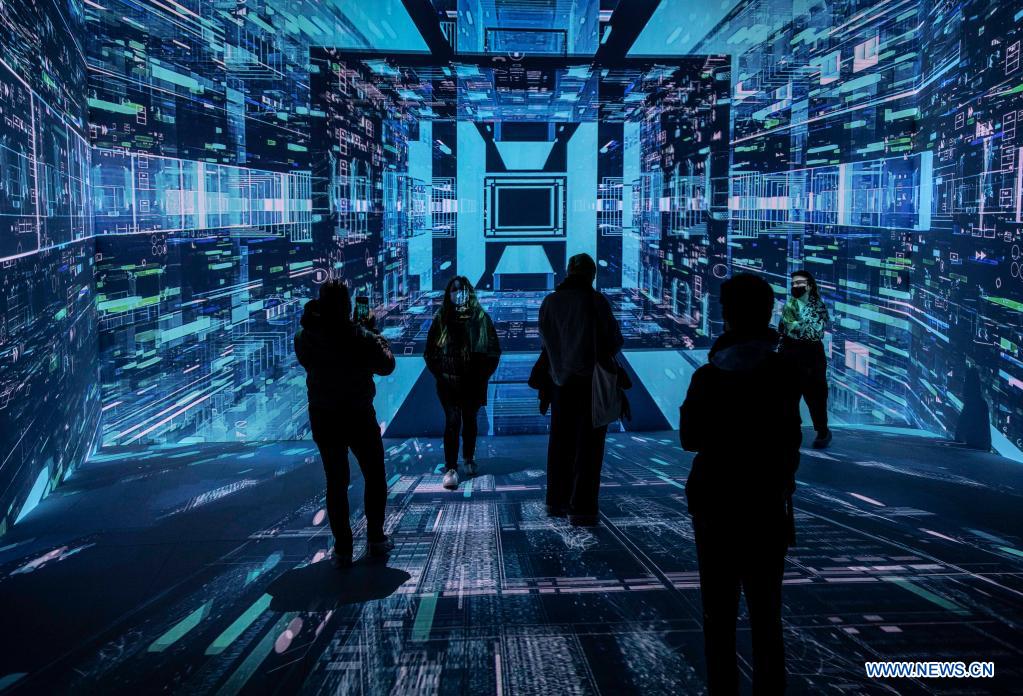
People visit the contemporary art exhibition "Machine Memories: Space" in Istanbul, Turkey, on April 1, 2021. The exhibition "Machine Memories: Space" created by using artificial intelligence (AI) and images recorded by space telescopes fascinates Istanbul's art lovers, luring thousands of visitors each day despite the COVID-19 pandemic. (Photo by Osman Orsal/Xinhua)
by Zeynep Cermen
ISTANBUL, April 2 (Xinhua) -- Despite late in afternoon, large crowds were still waiting in a queue in front of an art gallery in Istanbul to see the latest exhibition of the renowned Turkish contemporary artist Refik Anadol.
Gallery staff kept reminding those after the 200th person in the line not to wait, as they could not make it on time before the closure time at 5 p.m.
The exhibition "Machine Memories: Space" created by using artificial intelligence (AI) and images recorded by space telescopes fascinates Istanbul's art lovers, luring thousands of visitors each day despite the COVID-19 pandemic.
Sahika Pasolar was among the hundreds waiting for more than an hour outside of the Pilevneli gallery located at the Dolapdere neighborhood on the European side of the city to see Anadol's works.
"Everyone may have missed these kinds of activities," she told Xinhua, noting that people have long been deprived of exhibitions and museums due to the pandemic.
"This exhibition can be a start for all of us. We think that a wonderful experience awaits us inside," Pasolar noted, saying that it will be definitely worth the long wait.
Dolapdere was once known as a notorious neighborhood home to drug dealers and criminal gangs. But it has been evolving to a new contemporary art center, hosting several newly opened galleries and museums.
"The reaction is extremely positive probably because of the pandemic," Anadol told Xinhua in an online interview.
He said people have trouble reconnecting with life as the pandemic continues posing challenges both mentally and physically for all.
Anadol thinks that the exhibition has the power of recreating something exciting and inspiring for the audience, carrying a hope that at the end of each waiting, something remarkable would come.
"The pandemic has transformed how we produce, experience, and feel about art," he said, describing the pandemic era for him as "horrible" as he was not able to go anywhere and "stuck in the reality of physical boredom."
"That is one of the reasons why I trained AI with 200 million nature photos ... and with all the telescopes that I enjoyed," he said, naming his efforts purely "pandemic creativity."
In his exhibition, where he combined virtual reality with the physical realm, Anadol invited visitors to explore the depths of the universe.
The large-scale AI "data sculpture" that welcomes the audience in the first part of the exhibition titled Memories included three separate space mission archives recorded by International Space Station, Hubble, and the Magdalena Ridge Observatory telescopes.
The AI transformed more than two million images into pigments and created a constantly changing dynamic chart, and the output was displayed with the Symphony No. 2 in E minor, Op. 27 by the Russian composer Sergei Rachmaninoff.
"This exhibition reveals hope for many, showing that the world can be opened up again slowly and carefully, and people can still go back to their normal and enjoy the physical quality of life," he said.
In Anadol's view, there will be an explosion of arts and a boom of artistic experiences in the post-pandemic period. Enditem




